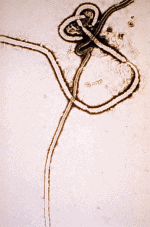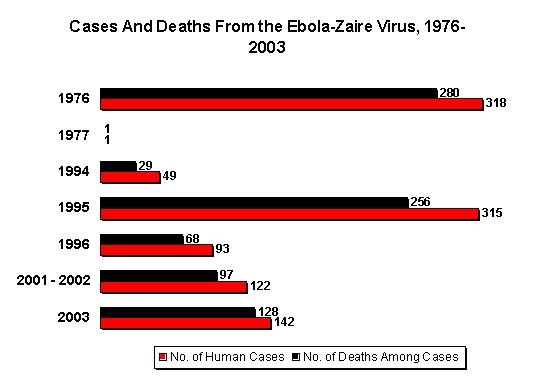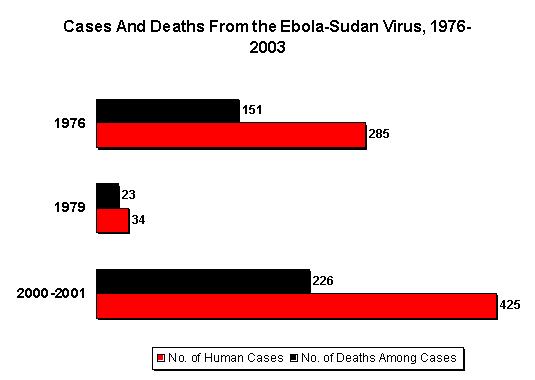Definition
Hemorrhagic fevers are caused by viruses that exist throughout the world. However, they are most common in tropical areas. Early symptoms, such as muscle aches and fever, can progress to a mild illness or to a more debilitating, potentially fatal disease. In severe cases, a prominent symptom is bleeding, or hemorrhaging, from orifices and internal organs.
Description
Although hemorrhagic fevers are regarded as emerging diseases, they probably have existed for many years. This designation isn't meant to imply that they are newly developing, but rather that human exposure to the causative viruses is increasing to the point of concern.
These viruses are maintained in nature in insect, arthropod (insects, spiders and other invertebrates with external hard skeletons), or animal populations--so-called disease reservoirs. Individuals within these populations become infected with a virus but do not die from it. In many cases, they don't even develop symptoms. Then the viruses are transmitted from a reservoir population to humans by vectors--either members of the reservoir population or an intervening species, such as mosquitoes.
Hemorrhagic fevers are generally endemic, or linked to specific locations. If many people reside in an endemic area, the number of cases may soar. For example, dengue fever, a type of hemorrhagic fever, affects approximately 100 million people annually. A large percentage of those infected live in densely populated southeast Asia; an area in which the disease vector, a mosquito, thrives. Some hemorrhagic fevers are exceedingly rare, because people very infrequently encounter the virus. Marburg hemorrhagic fever, which has affected fewer than 40 people since its discovery in 1967, provides one such example. Fatality rates are also variable. In cases of dengue hemorrhagic fever-dengue shock syndrome, 1-5% of the victims perish. On the other end of the spectrum is Ebola, an African hemorrhagic fever, that kills 30-90% of those infected.
The onset of hemorrhagic fevers may be sudden or gradual, but all of them are linked by the potential for hemorrhaging. However, not all cases progress to this very serious symptom. Hemorrhaging may be attributable to the destruction of blood coagulating factors or to increased permeability of body tissues. The severity of bleeding ranges from petechiae, which are pinpoint hemorrhages under the skin surface, to distinct bleeding from body orifices such as the nose or vagina.
Causes & symptoms
The viruses that cause hemorrhagic fevers are found most commonly in tropical locations; however, some are found in cooler climates. Typical disease vectors include rodents, ticks, or mosquitoes, but person-to-person transmission in health care settings or through sexual contact can also occur.
Filoviruses
Ebola is the most famous of the Filoviridae, a virus family that also includes the Marburg virus. Ebola is endemic to Africa, particularly the Republic of the Congo and Sudan; the Marburg virus is found in sub-Saharan Africa. The natural reservoir of filoviruses is unknown. The incubation period, or time between infection and appearance of symptoms, is thought to last three to eight days, possibly longer.
Symptoms appear suddenly, and include severe headache, fever, chills, muscle aches, malaise, and appetite loss. These symptoms may be accompanied by nausea, vomiting, diarrhea, and abdominal pain. Victims become apathetic and disoriented. Severe bleeding commonly occurs from the gastrointestinal tract, nose and throat, and vagina. Other bleeding symptoms include petechiae and oozing from injection sites. Ebola is fatal in 30-90% of cases.
Arenaviruses
Viruses of the Arenaviridae family cause the Argentinian, Brazilian, Bolivian, and Venezuelan hemorrhagic fevers. Lassa fever, which occurs in west Africa, also arises from an arenavirus. Infected rodents, the natural reservoir, shed virus particles in their urine and saliva, which humans may inhale or otherwise come in contact with.
Fever, muscle aches, malaise, and appetite loss gradually appear one to two weeks after infection with the South American viruses. Initial symptoms are followed by headache, back pain, dizziness, and gastrointestinal upset. The face and chest appear flushed and the gums begin to bleed. In about 30% of cases, the disease progresses to bleeding under the skin and from the mucous membranes, and/or to effects on the nervous system, such as delirium, coma, and convulsions. Untreated, South American hemorrhagic fevers have a 10-30% fatality rate.
Lassa fever also begins gradually, following an 8-14 day incubation. Initial symptoms resemble those of the South American hemorrhagic fevers, followed by a sore throat, muscle and joint pain, severe headache, pain above the stomach, and a dry cough. The face and neck become swollen, and fluid may accumulate in the lungs. Bleeding occurs in 15-20% of infected individuals, mostly from the gums and nose. Overall, the fatality rate is lower than 2%, but hospitals may encounter 20% fatality rates, treating typically the most serious of cases.
Flaviviruses
The Flaviviridae family includes the viruses that cause yellow and dengue fevers.
Yellow fever occurs in tropical areas of the Americas and Africa and is transmitted from monkeys to humans by mosquitoes. The virus may produce a mild, possibly unnoticed illness, but some individuals are suddenly stricken with a fever, weakness, low back pain, muscle pain, nausea, and vomiting. This phase lasts one to seven days, after which the symptoms recede for one to two days. Symptoms then return with greater intensity, along with jaundice, delirium, seizures, stupor, and coma. Bleeding occurs from the mucous membranes and under the skin surface, and dark blood appears in stools and vomit.
Mosquitoes also transmit the dengue virus. Dengue fever is endemic in southeast Asia and areas of the Americas. Cases have also been reported in the Caribbean, Saudi Arabia, and northern Australia. This virus causes either the mild dengue fever or the more serious dengue hemorrhagic fever-dengue shock syndrome (DHF-DSS).
In children, dengue fever is characterized by a sore throat, runny nose, slight cough, and a fever lasting for a week or less. Older children and adults experience more severe symptoms: fever, headache, muscle and joint pain, loss of appetite, and a rash. The skin appears flushed, and intense pain occurs in the bones and limbs. After nearly a week, the fever subsides for one to two days before returning. Minor hemorrhaging, such as from the gums, or more serious gastrointestinal bleeding may occur.
DHF-DSS primarily affects children younger than 15 years. The symptoms initially resemble those of dengue fever in adults, without the bone and limb pain. As the fever begins to abate, the individual's condition worsens and hemorrhaging occurs from the nose, gums, and injection sites. Bleeding is also seen from the gastrointestinal, genitourinary, and respiratory tracts.
Bunyaviruses
The Bunyaviridae family includes several hundred viruses but only a few are responsible for hemorrhagic fevers in humans.
Rift Valley fever is caused by the phlebovirus, found in sub-Saharan Africa and the Nile delta. Natural reservoirs are wild and domestic animals, and transmission occurs through contact with infected animals or through mosquito bites. The incubation period lasts 3-12 days. Most cases of Rift Valley fever are mild and may be symptomless. If symptoms develop, they include fever, backache, muscle and joint pain, and headache. Hemorrhagic symptoms occur rarely; while death, which occurs in fewer than 3% of cases, is attributable to massive liver damage.
Crimean-Congo hemorrhagic fever is caused by nairovirus and occurs in central and southern Africa, Asia, Eurasia, and the Middle East. The virus is found in hares, birds, ticks, and domestic animals and may be transmitted by ticks or by contact with infected animals. The nairovirus incubation period is 3-12 days; after which an individual experiences fever, chills, headache, severe muscle pain, pain above the stomach, nausea, vomiting, and appetite loss. Bleeding under the skin and gastrointestinal and vaginal bleeding may develop in the most severe cases. Death rates range from 10% in southern Russia to 50% in parts of Asia.
Hemorrhagic fever with renal (kidney) syndrome is caused by the hantaviruses: Hantaan, Seoul, Puumala, and Dobrava. Hantaan virus occurs in northern Asia, the Far East, and the Balkans; Seoul virus is found worldwide; Puumala virus is found in Scandinavia and northern Europe; while Dobrava virus occurs in the Balkans. Wild rodents are the natural reservoirs and transmit the virus via their excrement or body fluids or through direct contact. Initial symptoms develop within 10-40 days and include fever, headache, muscle pain, and dizziness. Other symptoms are blurry vision, abdominal and back pain, nausea, and vomiting. High levels of protein in the urine signal kidney damage; hemorrhaging may also occur. Death rates range from 0-10%.
Diagnosis
Since the hemorrhagic fevers share symptoms with many other diseases, positive identification of the disease relies on evidence of the viruses in the bloodstream--such as detection of antigens and antibodies--or isolation of the virus from the body. Disruptions in the normal levels of bloodstream components may be helpful in determining some, but not all, hemorrhagic fevers.
Treatment
Lassa fever, and possibly other hemorrhagic fevers, respond to ribavirin, an antiviral medication. However, most of the hemorrhagic fever viruses can only be treated with supportive care. Such care centers around maintaining correct fluid and electrolyte balances in the body and protecting the patient against secondary infections. Heparin and vitamin K administration, coagulation factor replacement, and blood transfusions may be effective in lessening or stopping hemorrhage in some cases.
Prognosis
Recovery from some hemorrhagic fevers is more certain than from others. The filoviruses are among the most lethal; fatality rates for Ebola range from 30-90%, while DHF-DSS cases result in a 1-5% fatality rate. Whether a case occurs during an epidemic or as an isolated case also has a bearing on the outcome. For example, isolated cases of yellow fever have a 5% mortality rate, but 20-50% of epidemic cases may be fatal.
Permanent disability can occur with some types of hemorrhagic fever. About 10% of severely ill Rift Valley fever victims suffer retina damage and may be permanently blind, and 25% of South American hemorrhagic fever victims suffer potentially permanent deafness.
Proper treatment is vital. In cases of DHF-DSS, fatality can be reduced from 40-50% to less than 2% with adequate medical care. For individuals who survive hemorrhagic fevers, prolonged convalescence is usually inevitable. However, survivors seem to gain lifelong immunity against the virus that made them ill.
Prevention
Hemorrhagic fevers can be prevented through vector control and personal protection measures. Attempts have been made in urban and settled areas to destroy mosquito and rodent populations. In areas where such measures are impossible, individuals can use insect repellents, mosquito netting, and other methods to minimize exposure.
Vaccines have been developed against yellow fever, Argentinian hemorrhagic fever, and Crimean-Congo hemorrhagic fever. Vaccines against other hemorrhagic fevers are being researched.
Key Terms
- Antibody
- A molecule created by the body's immune system to combat a specific infectious agent, such as a virus or bacteria.
- Antigen
- A specific feature, such as a protein, on an infectious agent. Antibodies use this feature as a means of identifying infectious intruders.
- Coagulating factors
- Components within the blood that help form clots.
- Endemic
- Referring to a specific geographic area in which a disease may occur.
- Hemorrhage
- As a noun, this refers to the point at which blood is released. As a verb, this refers to bleeding.
- Incubation
- The time period between exposure to an infectious agent, such as a virus or bacteria, and the appearance of symptoms of illness.
- Petechiae
- Pinpoint hemorrhages that appear as reddish dots beneath the surface of the skin.
- Reservoir
- A population in which a virus is maintained without causing serious illness to the infected individuals.
- Ribavirin
- A drug that is used to combat viral infections.
- Vector
- A member of the reservoir population or an intervening species that can transmit a virus to a susceptible victim. Mosquitoes are common vectors, as are ticks and rodents.
Further Reading
For Your Information
Books
- Garrett, Laurie. The Coming Plague: Newly Emerging Diseases in a World Out of Balance. New York: Farrar, Straus, and Giroux, 1994.
- Gorbach, Sherwood L., John G. Bartlett, and Neil R. Blacklow, editors. Chapters 266, 267, and 269 in Infectious Diseases. 2nd ed. Philadelphia: W.B. Saunders Company, 1998.
Periodicals
- Lacy, Mark D., and Raymond A. Smego. "Viral Hemorrhagic Fevers." Advances in Pediatric Infectious Diseases 12 (1997): 21.
- Le Guenno, Bernard. "Emerging Viruses." Scientific American October (1995): 56.
Other
- Outbreak. (An on-line information service about emerging diseases.) http://www.outbreak.org/.
Gale Encyclopedia of Medicine. Gale Research, 1999.




